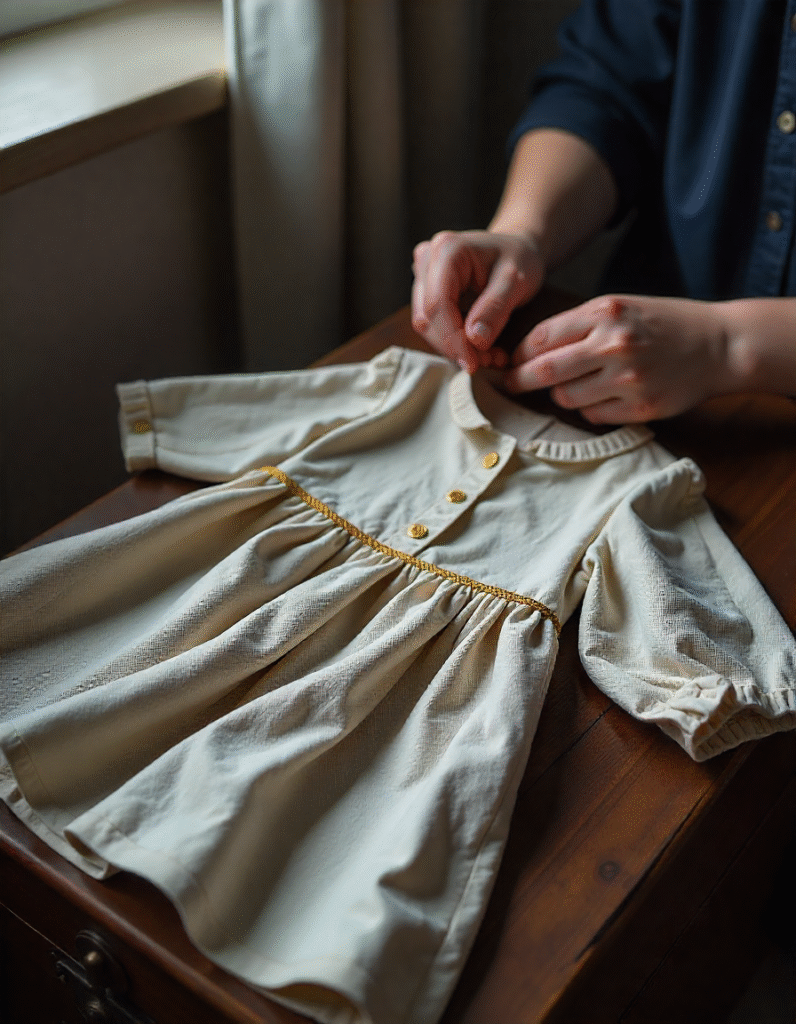In the back of a cedar closet, a child’s hand-me-down dress hangs—faded at the shoulders, soft as dandelion fluff. Its tiny buttons are loose, the hem frayed, but to the woman who reaches for it, it’s not fabric. It’s the scent of her grandmother’s kitchen, the scratch of wool against her six-year-old skin, the memory of twirling until dizzy at a family wedding. This dress is an archive—a textile diary of moments too precious for words. Yet in an era of hyper-consumption, we’ve forgotten this profound truth: clothing is never just clothing. It’s the silent witness to our lives, the keeper of our stories, the physical manifestation of memory itself. When we treat garments as disposable, we erase more than fabric—we erase fragments of our humanity.
The Neuroscience of Sartorial Memory: Why Clothes Trigger Time Travel
Neuroscientists have long known that scent triggers our most visceral memories—the madeleine phenomenon Proust described. But clothing operates similarly, engaging multiple senses to unlock emotional time travel. The Journal of Experimental Psychology published a study in 2022 showing that handling personal garments activates the brain’s default mode network—the same region engaged during autobiographical reflection. When you touch a well-worn jacket, your brain doesn’t just register texture; it accesses the context of that texture: the rain-soaked day you bought it, the concert where you wore it, the person who hugged you in it.
This phenomenon, called “tactile-emotional resonance,” explains why certain garments feel irreplaceable. A mother’s maternity shirt isn’t just fabric; it’s the stretch and pull of pregnancy, the first kicks felt beneath its seams. A soldier’s uniform carries the weight of camaraderie and loss. Even the mundane—a favorite college hoodie—holds the imprints of late-night study sessions, first heartbreaks, and the tentative steps toward adulthood.
Fashion conservators understand this intimately. At the Victoria & Albert Museum in London, garments aren’t preserved as artifacts but as “emotional containers.” Senior curator Sonnet Stanfill explains: “When we conserve a dress, we’re not just stabilizing threads. We’re honoring the life it absorbed. The faint perfume on a 1920s flapper dress? That’s someone’s youth. The worn elbows on a 1940s work shirt? That’s resilience.” This perspective transforms conservation from technical craft to sacred stewardship.
The Disposable Wardrobe: When Fashion Forgets Its Purpose
Fast fashion’s greatest crime isn’t environmental (though its impact is devastating) or ethical (though exploitation runs deep). Its greatest crime is the erasure of memory. When clothes are designed for 7 wears before discard—as the average fast-fashion garment lasts—they never accumulate stories. They remain empty vessels, forever new, never loved.
Consider the lifecycle of a $5 Shein dress:
- Birth: Synthetically dyed in a factory, touched by hands paid pennies.
- Life: Worn once for an Instagram post, then abandoned.
- Death: Landfill or incineration, its synthetic fibers releasing microplastics.
It never knows the intimacy of a body’s warmth, the stain of laughter-induced tears, the mend that extends its life. It dies anonymous. Contrast this with a Japanese boro coat—patched and repatched over generations by rural families. Each repair is a story: a harsh winter, a child’s growth, a marriage. The coat becomes a family tree in textile form.
This disposability creates what sociologist Christine Harold calls “sartorial amnesia.” Without garments that anchor us to our past, we drift in a perpetual present. We lose the ability to measure our growth through clothing. The jeans that no longer fit after pregnancy? Gone. The shirt that survived chemotherapy? Discarded. We’re left with a closet of strangers, each piece as forgettable as the last.
The Living Archive: Cultures That Weave Memory into Cloth
Across cultures, clothing has always served as memory technology. Long before written language, textiles recorded lineage, status, and history. These traditions offer blueprints for revaluing our wardrobes as living archives.
Japanese Boro: Born from rural poverty, boro is the art of mending textiles with sashiko stitching. Peasant families patched kimonos and futons with scraps of indigo-dyed fabric, creating garments that were both practical and poetic. Each repair was a testament to resilience. Today, boro inspires sustainable fashion, but its deeper lesson is about honoring a garment’s journey. A boro jacket isn’t beautiful despite its mends; it’s beautiful because of them.
Ghanaian Adinkra Cloth: The Akan people of Ghana stamp fabric with symbols representing proverbs, values, and historical events. The Sankofa bird—looking backward while moving forward—embodies the philosophy: “Return and get it.” Adinkra cloth isn’t worn; it’s read. It turns clothing into a wearable library of cultural wisdom.
Victorian Mourning Jewelry: While not clothing, this tradition exemplifies textile-based memory. Victorians wove hair from deceased loved ones into brooches and lockets. These weren’t morbid relics but tender keepsakes—physical connections to those lost. The practice treated the body itself as an archive, with hair as the ink.
Native American Ribbon Work: Plains tribes like the Lakota and Cheyenne use ribbons to create intricate geometric patterns on clothing. Each design carries clan identity, personal achievements, and spiritual beliefs. A ribbon shirt isn’t just attire; it’s a resume, a prayer, and a map of belonging.
These traditions share a common thread: they treat clothing as a continuum, not a commodity. Garments are begun by one generation, continued by the next. They absorb sweat, tears, and joy, becoming heavier with meaning over time.
The Modern Archive: Rebuilding Our Relationship with Clothing
Reclaiming clothing as archive requires intentionality. It’s not about rejecting fashion but about deepening our relationship with it. Here’s how:
1. Practice Garment Biography
Treat each piece in your wardrobe as a character in your life story. Ask:
- Where did this come from? (Not just the store, but the hands that made it.)
- What has it witnessed? (First dates, funerals, promotions.)
- How has it changed? (Faded, stretched, mended.)
Document these stories. A simple notebook with photos and notes transforms your closet into a curated exhibit.
2. Embrace Active Preservation
Conservation isn’t just for museums. Learn basic textile care:
- Store Wisely: Use cedar blocks for wool, acid-free tissue for silk.
- Clean Gently: Hand-wash delicate items; avoid dry-cleaning chemicals.
- Mend Meaningfully: Visible repairs (like sashiko or darning) add beauty and history.
The School of Stitching and Darning in London teaches “emotional mending”—repairing garments while reflecting on their significance. A student there patched her grandmother’s wedding dress with gold thread, turning a tear into a river of light.
3. Create Rituals of Release
When a garment truly reaches its end, honor its service. Don’t trash it; transform it.
- Upcycle: Turn a beloved shirt into a pillow, quilt, or art piece.
- Compost: Natural fibers like cotton and linen can return to the earth.
- Pass On: Gift items to others with their stories attached. A note saying, “This dress saw me through two job interviews and one great love,” gives the garment new life.
4. Build Legacy Garments
Invest in pieces designed to last generations. Brands like Ottoman Hands (heirloom jewelry) and Steed (bespoke tailoring) create items meant to be passed down. When commissioning such pieces, involve loved ones. A mother might have a coat made with her daughter, embedding a secret pocket with a handwritten note.
The Future Wardrobe: From Consumption to Curation
The most radical shift in fashion isn’t technological; it’s philosophical. It’s the move from accumulation to curation—from filling closets with disposable items to tending a living archive of meaningful pieces.
This shift is already emerging:
- Repair Cafés: Community spaces where people mend garments together, sharing stories as they stitch.
- Digital Archives: Apps like Smart Closet help users track garment histories, from purchase to repair.
- Slow Fashion Brands: Labels like Bode (using antique textiles) and Bethany Williams (working with marginalized communities) treat clothing as cultural heritage.
Even technology is adapting. Eon creates digital IDs for garments, tracking their lifecycle and enabling resale or recycling. But the most exciting development isn’t digital—it’s the return of human skills. Sewing, darning, and quilting are experiencing a renaissance among young people seeking connection.
The Unspoken Promise: What Our Clothes Owe Us
Clothing makes a silent promise: I will hold your stories. When we break that promise through neglect or disposal, we sever a link to our past. But when we honor it—when we mend, preserve, and cherish our garments—we create a bridge between generations.
Imagine your great-grandmother’s wedding veil, preserved in acid-free tissue. Imagine your child wearing your leather jacket, softened by decades of use. Imagine opening a cedar chest fifty years from now and touching a dress that still holds the scent of your youth.
This is fashion’s highest calling: not to adorn the body, but to archive the soul. In a world of fleeting digital connections and disposable everything, our clothes become the keepers of our humanity. They outlast trends, outlast apps, outlast even us. They are the woven proof that we were here—that we loved, lost, and lived.
The next time you reach for a garment, pause. Ask not just “Does this fit?” but “What story will this tell?” Choose clothes worthy of your memories. Mend them with care. Pass them on with wisdom.




















